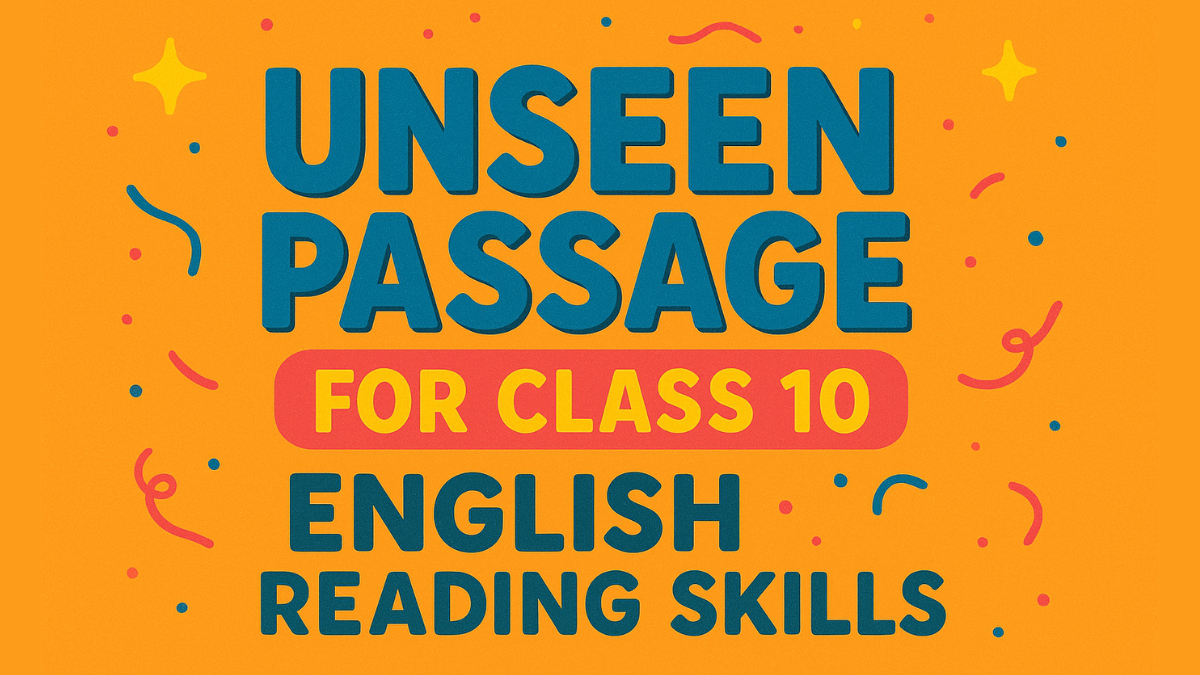Unseen Passages are one of the most important and easiest to score sections in the Class 10 English board examination. Unseen Passage in Class 10 English tests a student’s reading comprehension, ability to quickly analyse material, and accuracy in presenting responses. Many students underestimate this Class 10 English Unseen Passage, but with the appropriate approach and practice, you can get full points on it. For efficient preparation, we have shared some Sample Unseen Passages for Class 10 English with solutions to improve their Reading Skills and get familiar with the paper pattern.
Unseen Passage for Class 10 English Reading Skills
In Class 10 English Question paper, Unseen Passage cmes under reading comprehension Section in which Students are assigned a passage that they have never read before. The Class 10 English Unseen passage is followed by a series of questions about the topic, vocabulary, or inferences taken from the text. Students must read, comprehend, and answer these questions within a specific time constraint.
According to the CBSE Class 10 English test format, the Reading Section carries 10 marks, with the Unseen Passage accounting for a considerable portion of it. Along with the MCQ, students will encounter either one large passage or two shorter passages followed by questions.
Class 10 English Unseen Passage Questions with Answers
Read the following text and answer the following questions 10
(1) A thorough study conducted across several villages of north-west India unveiled fascinating insights into the mural* landscape. It revealed that a significant majority, comprising around 80%, of these vibrant artworks are meticulously crafted by the villagers
themselves. Approximately 15% of the murals stem from collaborative endeavours between villagers and local or visiting artists.
(2) Surprisingly, a small fraction, about 5%, of the murals are the result of sponsored initiatives, often commissioned by governmental or non-governmental organisations. These murals convey social messages ranging from education and environmental conservation to public health awareness.
(3) Among the locally crafted murals, nearly 55% depict scenes from mythology and folklore, celebrating the rich cultural heritage of the region. About 26 % of these murals showcase daily life in the villages, capturing moments of joy, struggle, and victory. The remaining
19% feature abstract or contemporary themes, reflecting evolving artistic expressions in rural settings.
(4) Further analysis reveals that among the locally crafted murals, nearly 63% are found on the walls of community centres, temples, and other public spaces. Around 27 % adorn the exterior walls of residential houses. The remaining 10% are scattered across schools,
health centres, and other institutional buildings, serving as educational tools and sources of inspiration for the younger generation.
(5) To delve deeper, comparisons across various parameters such as demographic patterns, subject matter, techniques, community engagement, and impact are crucial. Analysing these facets not only provides a comprehensive understanding of mural creation in
Northwest Indian villages but also unveils avenues for cultural preservation, community development, and creative expression.
* a large painting or artwork that is typically created directly on a wall or ceiling
Answer the following questions, based on the passage above
I. What does the use of the phrase ‘fascinating insights’ by the writer, in paragraph 1, tell us about their feelings?
A. The writer is expressing surprise.
B. The writer is conveying boredom and frustration.
C. The writer is indicating interest and enthusiasm.
D. The writer is showing disappointment.
Answer: C. The writer is indicating interest and enthusiasm.
II. Select the option that is true for the assertion and reason given below.
Assertion: The murals in northwest Indian villages are meticulously crafted.
Reason: The murals are the result of collaborative endeavours.
A. Both the assertion and reason are true, and the reason is the correct explanation of the assertion.
B. Both the assertion and reason are true, but the reason is not the correct explanation of the assertion.
C. The assertion is true, but the reason is false.
D. The assertion is false, but the reason is true.
Answer: C. The assertion is true, but the reason is false.
III. Identify the word that indicates that the writer anticipated a higher percentage of sponsored initiative murals?
Answer: Surprisingly
IV How do the murals in northwest Indian villages contribute to community engagement and awareness?
Answer: The murals serve as visual platforms for conveying important social messages, such as education, environmental conservation, and public health awareness / The murals not only beautify the village but also serve as educational tools and sources of inspiration, nurturing community engagement and promoting awareness of pressing issues
V Read the given prompt and select the correct option in the brackets to fill in the blank.
In Hari’s village, a mural depicting sustainable farming practices is showcased on the Panchayat office wall. The percentage of mural type that this would be counted in is. ______________ (26% / 19% / 55%)
Answer: 19% (category that features abstract or contemporary themes)
VI What does the highest percentage of different mural themes suggest about the artistic preferences and cultural priorities in northwest Indian villages?
Answer: Indicates – A deep-rooted connection to cultural heritage, as a significant portion (55%) of murals depict scenes from mythology and folklore / a desire to celebrate and preserve traditional narratives and values
VII Complete the sentence suitably.
The significant presence of murals on the exterior walls of residential houses highlights….
Answer: …the integration of art into everyday life / artistic skills of village folk/inclination to decorate exterior walls with local art/ pursue a form of artistic expression (accept any other logically relevant)
VIII Complete the following with a suitable reason.
The most likely reason the writer believes that a mural can serve as an ‘educational tool’ is because it can .
Answer: …convey information through vivid imagery and symbols, making complex topics
easier to understand and remember
- A holistic understanding of mural creation
- Researchers can –
- identify trends
- assess the significance of different themes
- understand the involvement of the community in mural projects
- evaluate the overall impact of murals on cultural preservation and community development
IX In the context of the last paragraph, describe the significance of comparing various parameters such as demographic patterns, subject matter, techniques, community engagement, and impact in understanding the mural landscape in northwest Indian villages.
How to Approach an Unseen Passage in Class 10 English?
Securing marks in this portion is comparatively easier because there is no need for subject memorisation or preparation. Instead, it rewards pupils who demonstrate high comprehension skills and can grasp and respond to the presented text. A step-by-step strategy can make solving Unseen Passages for the Class 10 English easier and faster.
- Read the questions first: Before reading the passage, review all of the questions. This offers you an idea of what details to look for while reading the passage.
- Skim the passage. Quickly: Read the passage once to grasp its broader meaning. Don’t waste too much time attempting to understand every single word at first.
- Read carefully the second time: Read it again, focusing on the elements relevant to the questions. Underline or jot down keywords that may assist you in answering.
- Answer in your own words: You should provide answers in very simple and to-the-point terms. It should be noted that copying full sentences from the passage should be avoided unless absolutely required. If any word limit is mentioned along with the questions, make your responses succinct and accurate.
- Focus on vocabulary-based questions: Some enquiries may enquire about the definitions of terms, synonyms, or antonyms. Use the sentence’s context to infer its meaning.










 CBSE Admit Card 2026 for Private & R...
CBSE Admit Card 2026 for Private & R...
 AILET 2026 AIR 1: Check Full Toppers Lis...
AILET 2026 AIR 1: Check Full Toppers Lis...
 AILET Result 2026 OUT, How to Download S...
AILET Result 2026 OUT, How to Download S...






